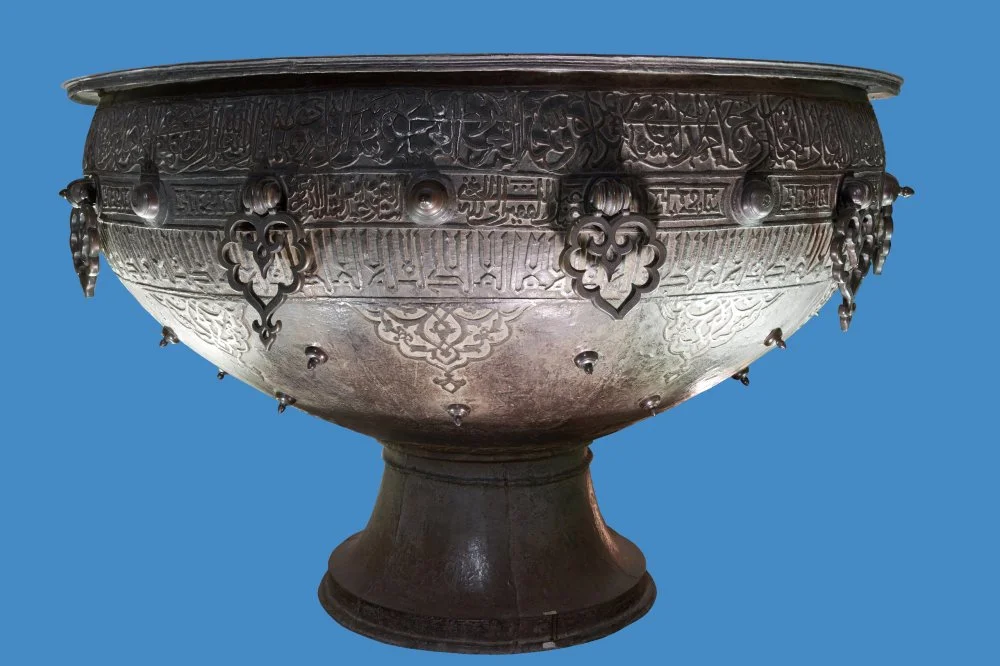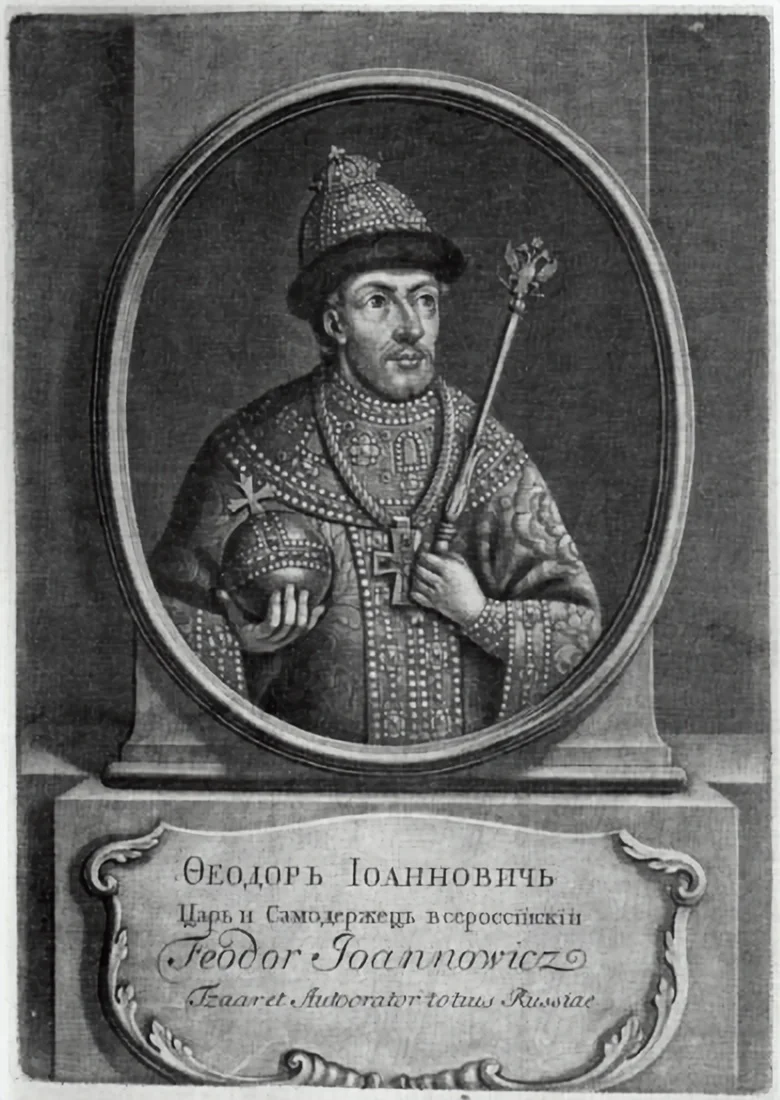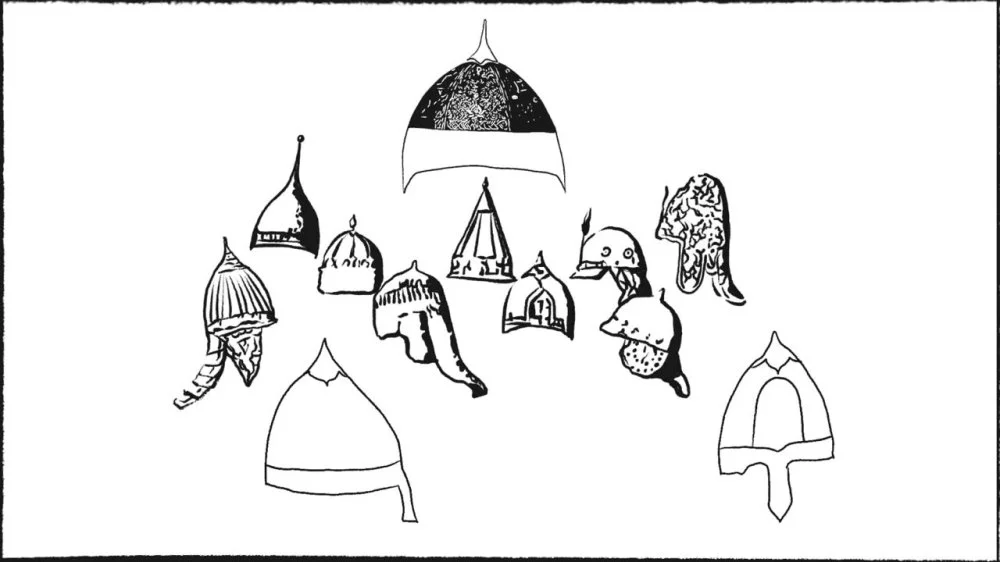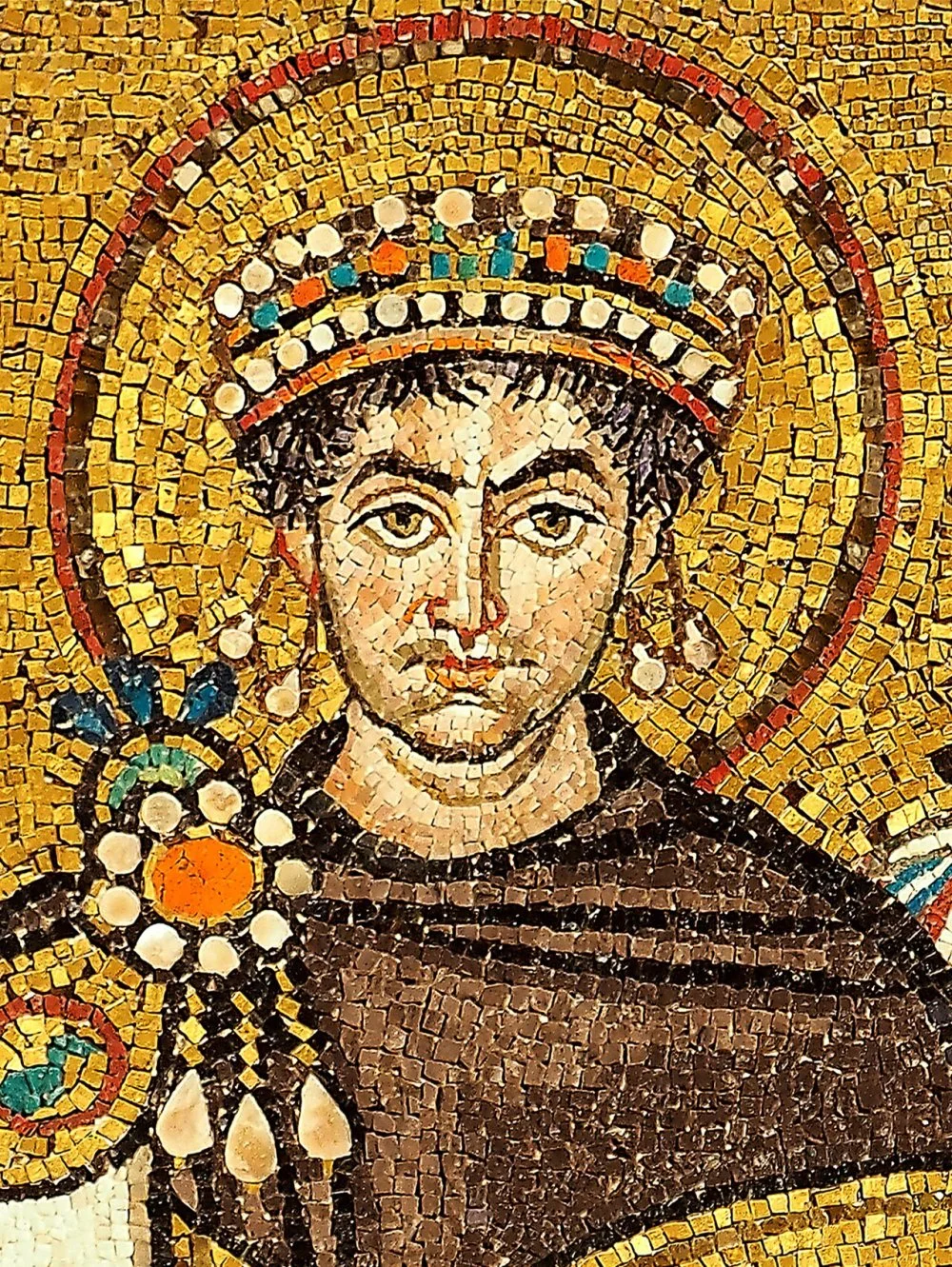
Monomakh's cap is presented at the exhibition «Coronation in the Kremlin» © Vladimir Astapkovich/RIA Novosti
Here’s a spoiler—it probably was, but it’s not a confirmed fact. Historians aren't sure if Monomakh's Cap was even any type of headgear, and some speculate that its elements originally adorned a bowl or a stand.
Since the beginning of the nineteenth century, after the Kremlin’s Armory Chamber first listed its inventory, Monomakh's Cap has been considered the most important artifact among the sacred regalia of the Russian Empire. In addition to the main headpiece, the Armory Chamber also has six replicas dating from the sixteenth and seventeenth centuries. These replicas include the Kazan Cap of Ivan the Terrible (1553), the hat worn by the first Romanov, Mikhail Fedorovich (1627), the Cap from Peter I's second ensemble (1682), the altabas hat (from Siberia) of Ivan V, and the diamond hats of Ivan and Peter (1680s). Crowns for emperors would be added on later.
In Alexander Pushkin's Boris Godunov, the character Boris Godunov, who was a favorite of Ivan the Terrible, the brother-in-law of Tsar Fydor Ivanovich, and who reigned as tsar (1598–1605), exclaims, ‘Heavy art thou, Monomakh's Cap!’ This is, in reality, a poetic exaggeration. The legendary crown weighs just around a kilogram (993.66 grams). You wouldn't want to wear it daily, but generally speaking, it's not that heavy. Unraveling the complexities of the history surrounding this ancient symbol of power is a much weightier task.
WHO WAS MONOMAKH?
Vladimir II Monomakh, the Grand Prince of Kyiv (1053–1125), was the son of Prince Vsevolod I Yaroslavich. He was married to a Byzantine princess from the Monomakh dynasty. The only emperor from this family to sit on the Byzantine throne was Constantine IX Monomachus (1042–1055), who became emperor through an affair with the empress. It was he who arranged a marriage between one of his relatives and the prince of Kyiv. However, her name is uncertain, with some sources suggesting Maria while others suggest Anastasia.
In the late fifteenth to sixteenth centuries, Moscow scribes, possibly commissioned by authorities keen on asserting their importance and grandeur, penned The Tale of the Princes of Vladimir. According to this story, the princes of Moscow were the descendants of the Roman emperor Augustus. The Byzantine emperor Constantine IX allegedly passed down to Vladimir Monomakh, his supposed ‘grandson’, a wine goblet, necklace, the life-giving cross (crafted from the wood of the cross of the Crucifixion), and the royal crown, all purportedly from Emperor Augustus himself.
Constantine IX is said to have literally taken the crown off his head and placed it on a golden plate and declared, ‘Take all this to be crowned on the throne of your free and autocratic kingdom.’ Since then, this crown has been known as Monomakh's Cap. Another equally fantastical account affectionately refers to it as ‘Monomakh's Little Hat’ and traces its origin back to the crown of the Babylonian king Nebuchadnezzar II. Allegedly, the Byzantine emperor received it from Nebuchadnezzar himself, and centuries later, Constantine Monomakh passed it on to Vladimir Monomakh (from The Tale of Babylonian Kingdom in the late sixteenth to seventeenth centuries).

Grand Prince Vladimir II Monomakh of Kiev/Alamy
Historians in the eighteenth and nineteenth centuries convincingly disproved this rather clumsy fabrication. Emperor Constantine IX died fifty years before Vladimir assumed leadership of his princely house. Moreover, Vladimir was just two years old at the time of the emperor's death, and these texts were riddled with other absurdities as well. It's worth mentioning that Vladimir's nickname ‘Monomakh’, which refers to him being a descendant of Emperor Constantine IX Monomachos, didn't become widely recognized until later, probably because of the legends surrounding the Cap.
A CAP FOR A WOMAN?
In 1328, a ‘golden cap’ was mentioned in the records (dukhovnaya) of Ivan Kalita, the grand prince of Moscow (1322/1325–1340), bequeathed to his eldest son, Semyon. Later, it is mentioned in the wills of other princes in the fourteenth and fifteenth centuries. These are, it must be said, the only undisputed facts about Monomakh’s Cap amidst the colorful legends and bold assumptions of historians. Thus, it is commonly held that Ivan Kalita received this cap from the Khan of the Golden Horde, Uzbek (1313–1341). The reasoning behind this is straightforward: who else would give it to the influential Moscow prince, known for his astuteness, but the powerful suzerain who held him in high regard?

Emir Timur (1370-1405)/Wikimedia commons
The legends from the sixteenth century have a much more romantic appeal. According to one version, the Cap wasn't a gift from the Byzantine Basileus (the Greek title for emperor) but was instead obtained through a successful military campaign against Byzantium. In this tale, Vladimir Monomakh was confused with Vladimir the Saint, who, in the tenth century, through a campaign in the Byzantine Chersonesus, married a Byzantine princess and, consequently, received a royal crown.
Another popular legend suggested that Vladimir Monomakh took the golden ‘attributes’ from the Genoese ruler of Caffa (Theodosia). However, there were no Genoese in Crimea during the eleventh or twelfth centuries. The Genoese established their factory in Caffa on the territory of the Crimean Horde in 1266. Its heyday coincided with the reign of Khan Uzbek in Sarai and Ivan Kalita in Moscow. One could theorize that this legend preserved Kalita's recollection of obtaining the ‘golden cap’ in Caffa. As they described him then, the prince had quite the penchant for acquiring (much like a modern shopaholic). However, once again, this remains mere speculation.
Professor G.F. Valeeva-Suleymanova took the legends and theories a step further, suggesting that the Cap was initially designed as a feminine headpiece, with feathers or even an entire sultani

Toy-kazan - translates to "wedding kazan", a kazan big enough to prepare food for wedding guests. 14 сentury/Shutterstock
OR PERHAPS A BOWL OR A STAND?
At the start of the twentieth century, archeologist A.A. Spitsyn, one of the first to conduct research into Monomakh's Cap, observed that the Cap's shape was awkward and unnatural. It was oversized for a typical head and would have rested like a pot, covering the forehead and eyes. However, it is worth noting another headgear could have been worn underneath the Cap, resolving that issue.
Additionally, the golden plates were not designed to be fastened together and are essentially held in place solely by gravity inside the display case. Attempting to try the Cap on is not advisable, not just because of the related superstitions but also because it could potentially fall apart. From this observation, Spitsyn inferred that the metal plates were likely initially crafted to cover a stand or a bowl, or perhaps to adorn another metal or wooden artifact. However, while this scenario is plausible, it is certainly not definitive.
AND WHAT ABOUT THE SAME CAP IN THE ARMORY CHAMBER?
Originally in Rus’, a new prince was simply ceremonially enthroned. The inclusion of the golden cap in the enthronement ceremony dates back to 1498 when Dmitry Ivanovich, the grandson and co-ruler of Ivan III,1
The portrayal of how such a crown might have appeared was initially given by Sigismund Herberstein, an emissary of the Holy Roman Empire who traveled to Muscovy in the early sixteenth century. While Herberstein's narrative style tends to be relatively dry and occasionally dull, in this instance, amidst the plethora of imaginative tales, his text is valued for its moderation. ‘A hat in their language is called a “schapka”,’ Herberstein wrote. He also mentioned Vladimir Monomakh, but more importantly, he described the precious regalia in intricate detail, and it's not quite like what we see today. The Cap was adorned with precious stones and decorated with ‘golden plates that swayed, twisting like little serpents’. In another version, he specifies that the small serpents were suspended on golden wires.

Coronation of the Grand Duchy of Dmitry Ivanovich in 1498. Miniature of the 16th century/Wikimedia commons
It's intriguing that the Cap stored in the Armory Chamber has more holes along the bottom edge of the gold plates than necessary for attaching them to the fabric base. Perhaps golden wires with snake-shaped plates were woven into them? Does this mean the royal crown swayed and jingled like a tambourine as it moved, akin to a jester's cap?! That’s not a question we will receive answers to! Moreover, it is also possible that Herberstein might have seen an alternative or reserve Cap.
All researchers concur that the fur trim and the cross-shaped finial are the youngest parts of the Cap, whereas the central petal-shaped plates are undoubtedly ancient. However, caps worn by the nobility in Rus' always featured fur trim. For example, Jacques Margeret, a French officer serving in Russia in the early seventeenth century, described the Russian cap in a remarkable manner: ‘These caps entirely lacked brims but were crafted exactly like soup bowls without handles, and atop the cap was a tall hat made of black fox fur.’ One could speculate that such a fur trim resembling a ‘soup bowl without handles’ was also present on Monomakh's Cap long ago, but as we recall, Herberstein did not mention it.

Feodor I of Russia by Johann Stenglin. 18th century/Wikimedia commons
Enthralled by the swaying of the snake-shaped plates, Herberstein says nothing about the finial of the Cap. Drawing on comparisons with other headgear, historians suggest that the finial initially could have been something like a helmet crest, similar to those on military helmets, a spike or rosette for securing feathers or a sultan. Moreover, if we delve deeper into speculation, it's conceivable that the original headpiece didn't feature a fur trim at the base but rather a rim or hoop. Essentially, the Cap might have originally served as a ceremonial princely helmet. This would explain how such an expansive headpiece could sit on the head and how the plates were secured.

Russian helmets. 12-14 centuries/Qalam
However, according to iconography, by the mid-sixteenth century, the golden cap featured both a fur trim and a finial in the shape of an apple. This exact cap was indeed placed upon Ivan the Terrible’s head in 1547 as a symbol of royal authority.
BUT WHO ACTUALLY CRAFTED THE CAP?
Given the confusion in written sources, historians must rely on the Cap itself to uncover its origin and the time of its creation. The background of the central plates of the Cap forms a large spiral with many rounded coils with smaller spirals branching off from them, reminiscent of a rich Eastern carpet. Traditional jewelry techniques such as filigree and granulation were employed during the crafting process. Filigree is a pattern made by soldering thin gold wire twisted into ropes onto a metallic background. Granulation consists of tiny grains or beads soldered onto the filigree pattern to add volume to the main design.
The patterns sometimes resemble indefinite flowers and rosettes. Among them, a hexagram suddenly appears, resembling a six-pointed Jewish star, on one of the plates. There is also the ‘Arabian flower’ on the Cap, originally thought to be a field lily or lotus, possibly stemming from the flower of the Assyrian ‘tree of life’. In addition, pearls, large emeralds, rubies, and red spinels are attached to the plates.
Essentially, two main versions of who had crafted the Cap emerged among historians as early as the beginning of the twentieth century. It was either Byzantium or the East. The difficulty with Byzantium lies in the fact that it was a crucial contact zone between ancient Greco-Roman culture and Eastern cultures, and it's not always clear where Byzantium ends and the East begins. The same Arabesque flower, popular in the East, especially after the Mongol conquests, finds parallels in the lotus flower, which is also known in Byzantine art.

Drawing of Monomakh's Cap Plates/Musemus of The Moscow Kremlin
Other historians argued that the plates of the Cap could have been made by the Central Asian craftsmen of the Horde, either directly by the Horde's artisans or by Crimean masters, possibly Syrians or even Egyptians. This is not mere speculation. The Horde maintained close allied relations with Mamluk Egypt and could have acquired various curiosities there.
The supporters of an Eastern, possibly Horde, origin of the Cap have long dominated the field of scholarship. However, an alternative, almost exotic, idea was once proposed: that the Cap was actually made in Moscow, in the workshop of Metropolitan Photius in the fifteenth century. This is the most recent among the existing dating hypotheses. Other estimates range from the twelfth to the fourteenth centuries.
Regardless, the Moscow principality grew out of the Ulag Ulus of the Golden Horde and developed within its cultural space for many years, from where, perhaps, the legendary Cap originated. At that time, such an origin didn't concern anyone and even added extra credibility to the prince's authority. At one point, by the end of the fifteenth century, when the Horde had already disintegrated, Moscow began to seek other pillars of legitimacy, and it turned to Byzantine history. Nevertheless, the link to Eastern Rome was purely superficial. In the Moscow of that era, Greek was unknown to most (except for occasional Greek visitors), and based on the conjecture about the Cap, there was little grasp of Byzantine history or familiarity with the appearance of the Basileus’s diadems.

Mosaic of Iustinianus I. San Vitale (Ravenna)/Wikimedia Commons